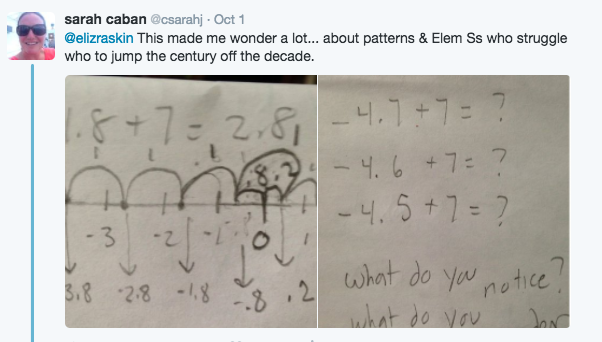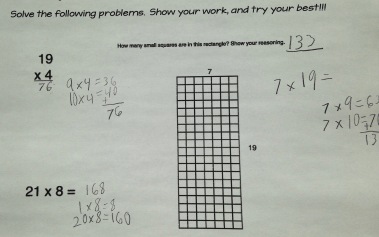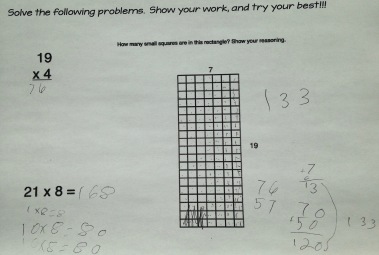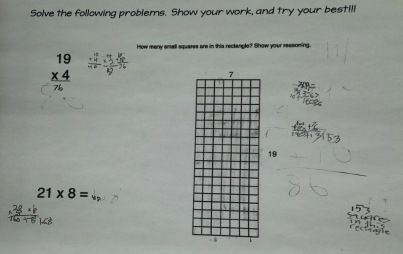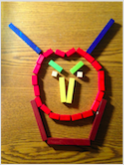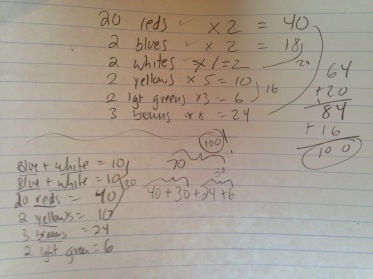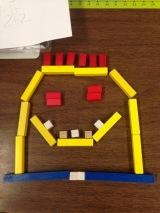One recent morning, my son, daughter, husband and I were trying to count the flock of turkeys in our front yard.
“I got 19.”
“I see 20… no 21, there is one in the ditch!”
“Wait. Three more just came out of the woods.”
“No. I already counted them.”
“Somebody take a picture!”
My son took a picture and we used it to help us organize our thinking. It turns out there were 24 turkeys in our yard. It took us a little while to prove it. We had to work together and we needed some tools to help us organize our thinking.
This week, I had the pleasure of joining the kindergarten teachers for a Learning Lab. Recently, we have been exploring how we can create more opportunities for students to “play” with the math they are learning. We have also been discussing what productive struggle looks like in Kindergarten. We decided to create a giant ten frame, present it to the students, and see what they noticed and wondered. We brought different materials to the meeting: clear shower curtains, felt, tablecloths, duct tape, and Sharpies. Each teacher created their own giant ten frame. Then, we brainstormed questions we wanted to ask Kindergarten students and we predicted what they might say and do.
We wondered:
- Will they recognize it as a ten frame?
- Will they use it to problem solve?
- Can we engage them in productive struggle? If yes, how will we know it is productive? How long will it last before it becomes unproductive?
When the students first came in, they sat around the ten frame and we asked them what do you notice?
- “It is Memory.”
- “It is a ten frame.”
- “It is five frame.”
- “a 6 frame”
- “a 7 frame”
- “an 8 frame”
- “a 9 frame”
- “a 17 frame”
- “a hund… a hund… an infinity frame!”
- “It’s soft!”

Okay, so now that you have been sufficiently introduced to the lesson, I will tell you that teaching Kindergarten students terrifies me. I have read books and taken classes about teaching Kindergarten students math. I am very familiar with the Kindergarten Common Core math standards. I have repeatedly read the Common Core progression for counting and cardinality.
All of this goes out the window when I walk into a classroom of 5 year olds. They are so alive! They are growing right in front of me – constantly trying to make sense of their world and how they fit into it. How do I get from the books, classes, and standards to the actual little people standing in front of me (without any of us (including me) ending up under the table in tears)?
Fortunately, I work with an amazing group of Kindergarten teachers who I am constantly learning with and from. At our grade level meetings, we have cultivated a space where it is okay to take risks because we support each other. So here is me knee-deep in my own risk taking:
It might look like I am nodding and smiling, but really, I am thinking, “11? 62? 100? 73? 9 frame? infinity frame? two five frames? What am I supposed to do with all this???? Do these kids see ten or not? Help me!!” At this point, I am experiencing productive struggle. I am trying not to panic. I decide to move forward with the exploration.
I asked them, “What could we do with (this big frame)? Do you have any ideas?” Several kids wanted to play memory.
One girls said, “I think we could all sit on one square.”
I asked, “Do you want to sit on a square?”
“Yes.”
Then, all the students started immediately and simultaneously scooching towards the ten frame.
Me: (heart rate increasing) “Hold on. Hold on. Let’s go one at a time. I pointed to the student who came up with the idea, “You came up with the idea, why don’t you find a square to sit on.”

Okay. That went well. So, I pointed to one other student and said, “go ahead.” Then this happened:

“Hold on. Hold on. Hold on. Back up. Back up. Wait one second.” I wondered, how do Kindergarten teachers do it? How do they build space for productive struggle without completely losing every kid to distraction or impulsivity? I decided to ask for help. I turned to one of my brilliant Kindergarten teaching colleagues and asked her what she wanted to know. Watch what happened next:
I found this fascinating. What is going on here? I thought some of the students were counting the empty spaces on the ten frame, but then when I asked them to explain, they didn’t really have much to say about it. Were they changing their thinking because other students started counting students? In the end, I followed Mark’s lead and tried to steer everybody towards figuring out how many kids were on the ten frame and how many kids were off the ten frame?
What happened next was really interesting. One of the girls said, “Hey. Can we get in a line so we can count?” My favorite part of the next clip is an exchange between Christy and I. I think we are both wondering how long this will last before everyone falls apart. What do you think? Are we still struggling productively?
So, after everybody was lined up, I figured this was it. They would count who was in the line and clearly see it was 12. Well that is not what happened. And we, the adults, were starting to get squirmy. We REALLY wanted to help. It was hard for us to watch these little people struggle. Even Mark was trying to figure out why on earth did his peers keep getting 11 for an answer when he got 12? Check it out.
Here is where I say a big giant thank you to Pam. I went into this lesson with the intention of trying to figure out what it looked like for kindergarteners to struggle productively. I learned pretty quickly that I couldn’t keep the struggle productive by myself. I knew I didn’t want to feed the kids the answers, but I didn’t have enough experience to know how to scaffold the struggle. Pam came up with a scaffold that allowed the struggle to linger a little longer and still stay productive. Thank you Pam for supporting MY productive struggle. As you can see, maintaining a neutral voice is not really my “thing.” I got pretty darn excited when Evvy figured out that Henry was forgetting to count himself. Sometimes, you gotta throw neutrality out the window and celebrate a lightbulb moment.
At this point, I wondered whether I should just end on a happy celebration. Yay! We all know how many kids are not on the ten frame. It is 12. Great struggle. Go ahead and have a snack. After all, we have been struggling for a solid 15 minutes, right. But….. I couldn’t help myself. It was like I was addicted to pursuing the struggle. Could we go a little further? Could we just push a little bit more? Sure. Why not?
Now I have to say a big thank you to Christy. She knew when to jump in with a good ole’ “prove it!” We had talked about it enough. We had the ten frame right in front of us. Let’s just get on with it. And so we did.
After the kids left, the teachers and I sat down to debrief. I asked them, what did they notice? They said:
- “The students were practicing so much: 1-1 correspondence, subitizing, solving for unknowns, adding and subtracting!”
- “They were involved in high levels of analysis and using a lot of language.”
- “The lesson moved from conceptual to procedural.”
- “My favorite part was when they noticed that they all wouldn’t fit on the ten frame.”
- “I really enjoyed the opportunity to watch my own students. There were some surprises. Some students who don’t usually talk were speaking up. Some students showed me they had a better understanding of 1-1 correspondence than I had seen in the past.”
Then, I asked the teachers, what would you do next?
- “I would bring it out again.”
- “Could you bring out number cards – show me this number in the ten frame?”
- “After we have done it physically, I might add objects to manipulate. Roll the dice and put the objects in.”
- “I like the idea of exploring.”
And finally, I asked the teachers, what did they learn?
- “You taught me to let go a little bit. They are learning. They are the ones doing it. “
- “They are engaged in real life problem solving. They will transfer it to make a decision down the road. “
And what did I learn?
I learned that counting is hard and so is teaching it in a rich and meaningful way. I also learned that Kindergarten students are beautiful little people who want to move, talk, organize themselves and each other, articulate their opinions, share, explore, and count. I am just a little bit less terrified about supporting them.
I also learned that the kindergarten teachers in our district our thoughtful, reflective, observant, curious, knowledgeable, and so very patient.



